Dissertation: Interest Rate Impact on Commercial Banks, Tajikistan
VerifiedAdded on 2023/01/23
|78
|33590
|89
Thesis and Dissertation
AI Summary
This dissertation delves into the impact of interest rate variations on commercial banks in Tajikistan, particularly in the context of financial liberalization and the country's accession to the World Trade Organization (WTO). The study begins with an introduction that outlines the background, research problem, aims, objectives, research questions, and methodology, including a brief overview of the thesis structure. Chapter 2 provides an extensive literature review, exploring existing theories on interest rate fluctuations, the current state of interest rates in Tajikistan, and the effects of interest rate liberalization. It also compares Tajikistan's interest rate policies with those of its neighboring countries. Chapter 3 focuses on the research methodology, detailing the theoretical paradigm, research design, data collection methods (primary and secondary), sampling techniques, and ethical considerations. The research aims to determine the relationship between interest rates and commercial banks in Tajikistan, examine the factors influencing interest rate fluctuations, analyze the impact of interest rate liberalization on the financial system, and compare Tajikistan's policies with those of its neighbors. The study highlights the challenges and opportunities for commercial banks in Tajikistan within the evolving financial landscape.
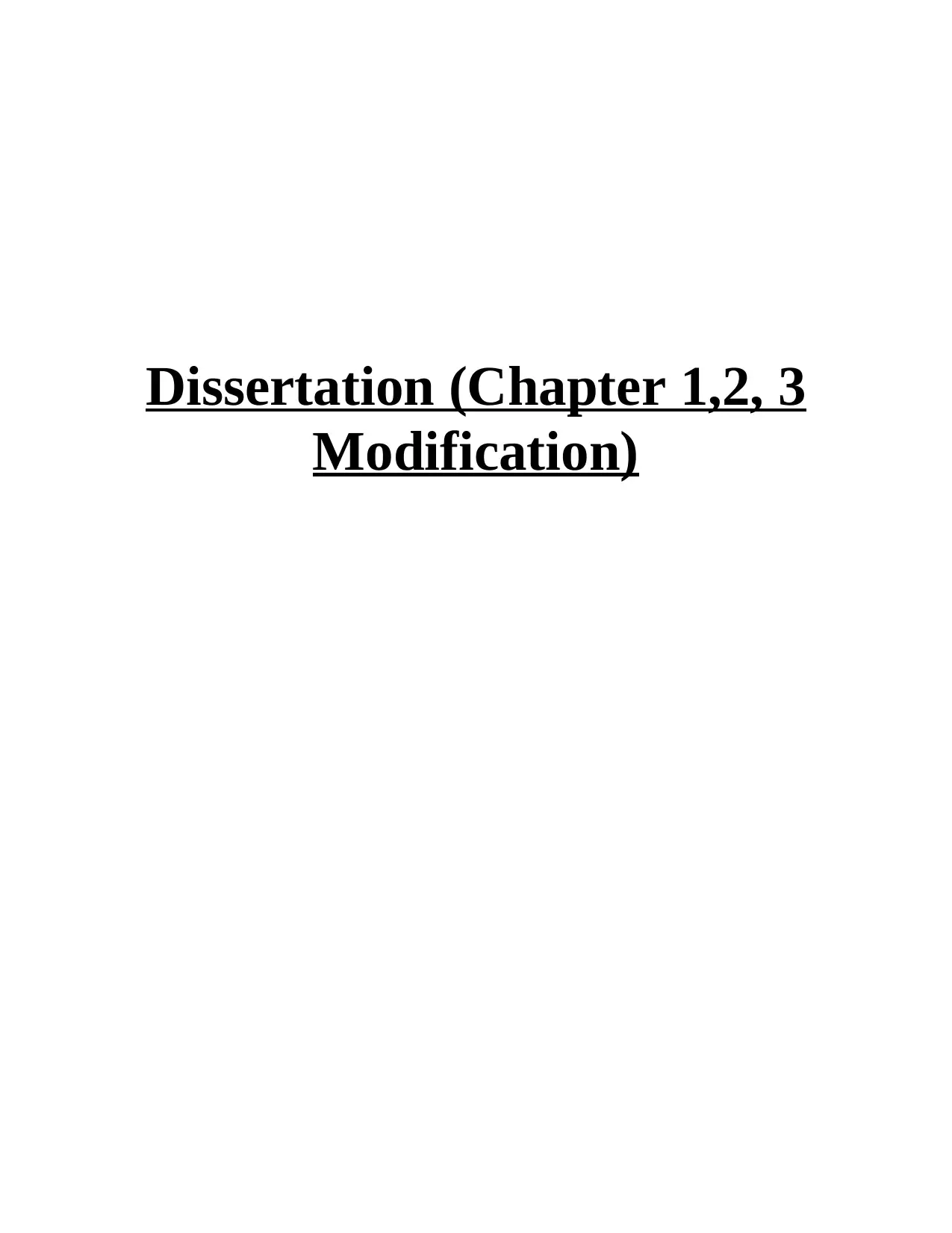
Dissertation (Chapter 1,2, 3
Modification)
Modification)
Paraphrase This Document
Need a fresh take? Get an instant paraphrase of this document with our AI Paraphraser
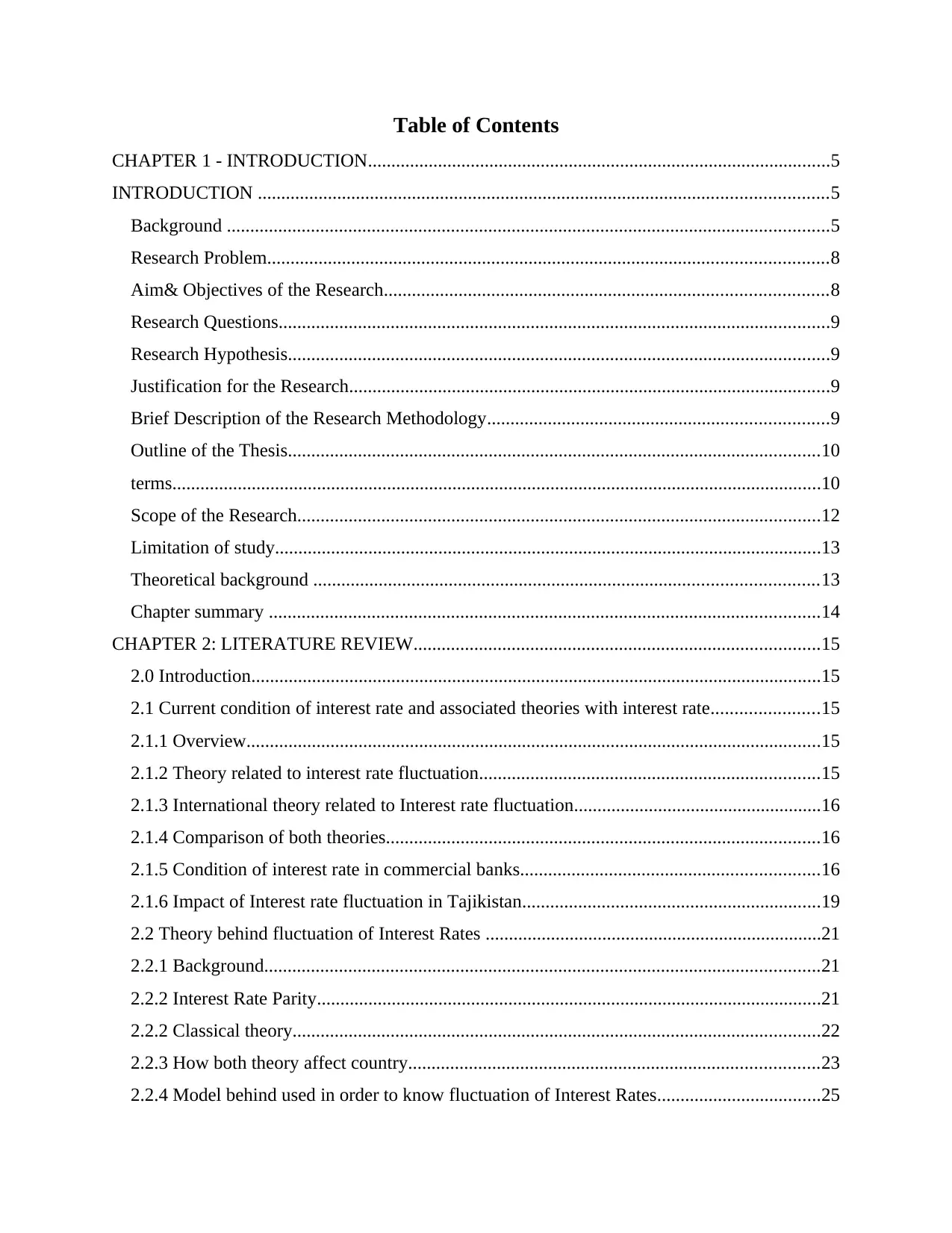
Table of Contents
CHAPTER 1 - INTRODUCTION...................................................................................................5
INTRODUCTION ..........................................................................................................................5
Background .................................................................................................................................5
Research Problem........................................................................................................................8
Aim& Objectives of the Research...............................................................................................8
Research Questions......................................................................................................................9
Research Hypothesis....................................................................................................................9
Justification for the Research.......................................................................................................9
Brief Description of the Research Methodology.........................................................................9
Outline of the Thesis..................................................................................................................10
terms...........................................................................................................................................10
Scope of the Research................................................................................................................12
Limitation of study.....................................................................................................................13
Theoretical background ............................................................................................................13
Chapter summary ......................................................................................................................14
CHAPTER 2: LITERATURE REVIEW.......................................................................................15
2.0 Introduction..........................................................................................................................15
2.1 Current condition of interest rate and associated theories with interest rate.......................15
2.1.1 Overview...........................................................................................................................15
2.1.2 Theory related to interest rate fluctuation.........................................................................15
2.1.3 International theory related to Interest rate fluctuation.....................................................16
2.1.4 Comparison of both theories.............................................................................................16
2.1.5 Condition of interest rate in commercial banks................................................................16
2.1.6 Impact of Interest rate fluctuation in Tajikistan................................................................19
2.2 Theory behind fluctuation of Interest Rates ........................................................................21
2.2.1 Background.......................................................................................................................21
2.2.2 Interest Rate Parity............................................................................................................21
2.2.2 Classical theory.................................................................................................................22
2.2.3 How both theory affect country........................................................................................23
2.2.4 Model behind used in order to know fluctuation of Interest Rates...................................25
CHAPTER 1 - INTRODUCTION...................................................................................................5
INTRODUCTION ..........................................................................................................................5
Background .................................................................................................................................5
Research Problem........................................................................................................................8
Aim& Objectives of the Research...............................................................................................8
Research Questions......................................................................................................................9
Research Hypothesis....................................................................................................................9
Justification for the Research.......................................................................................................9
Brief Description of the Research Methodology.........................................................................9
Outline of the Thesis..................................................................................................................10
terms...........................................................................................................................................10
Scope of the Research................................................................................................................12
Limitation of study.....................................................................................................................13
Theoretical background ............................................................................................................13
Chapter summary ......................................................................................................................14
CHAPTER 2: LITERATURE REVIEW.......................................................................................15
2.0 Introduction..........................................................................................................................15
2.1 Current condition of interest rate and associated theories with interest rate.......................15
2.1.1 Overview...........................................................................................................................15
2.1.2 Theory related to interest rate fluctuation.........................................................................15
2.1.3 International theory related to Interest rate fluctuation.....................................................16
2.1.4 Comparison of both theories.............................................................................................16
2.1.5 Condition of interest rate in commercial banks................................................................16
2.1.6 Impact of Interest rate fluctuation in Tajikistan................................................................19
2.2 Theory behind fluctuation of Interest Rates ........................................................................21
2.2.1 Background.......................................................................................................................21
2.2.2 Interest Rate Parity............................................................................................................21
2.2.2 Classical theory.................................................................................................................22
2.2.3 How both theory affect country........................................................................................23
2.2.4 Model behind used in order to know fluctuation of Interest Rates...................................25
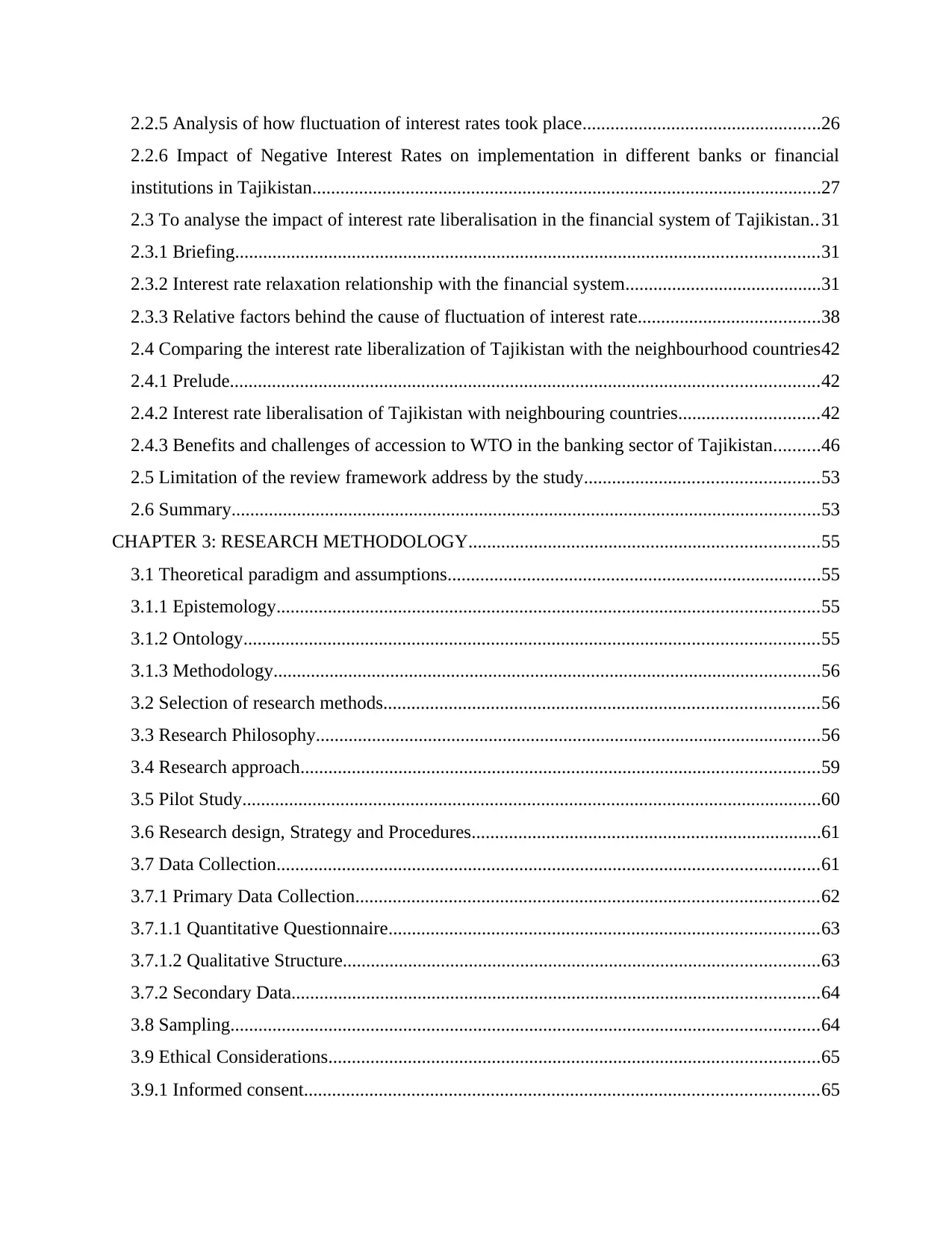
2.2.5 Analysis of how fluctuation of interest rates took place...................................................26
2.2.6 Impact of Negative Interest Rates on implementation in different banks or financial
institutions in Tajikistan.............................................................................................................27
2.3 To analyse the impact of interest rate liberalisation in the financial system of Tajikistan..31
2.3.1 Briefing.............................................................................................................................31
2.3.2 Interest rate relaxation relationship with the financial system..........................................31
2.3.3 Relative factors behind the cause of fluctuation of interest rate.......................................38
2.4 Comparing the interest rate liberalization of Tajikistan with the neighbourhood countries42
2.4.1 Prelude..............................................................................................................................42
2.4.2 Interest rate liberalisation of Tajikistan with neighbouring countries..............................42
2.4.3 Benefits and challenges of accession to WTO in the banking sector of Tajikistan..........46
2.5 Limitation of the review framework address by the study..................................................53
2.6 Summary..............................................................................................................................53
CHAPTER 3: RESEARCH METHODOLOGY...........................................................................55
3.1 Theoretical paradigm and assumptions................................................................................55
3.1.1 Epistemology....................................................................................................................55
3.1.2 Ontology...........................................................................................................................55
3.1.3 Methodology.....................................................................................................................56
3.2 Selection of research methods.............................................................................................56
3.3 Research Philosophy............................................................................................................56
3.4 Research approach...............................................................................................................59
3.5 Pilot Study............................................................................................................................60
3.6 Research design, Strategy and Procedures...........................................................................61
3.7 Data Collection....................................................................................................................61
3.7.1 Primary Data Collection...................................................................................................62
3.7.1.1 Quantitative Questionnaire............................................................................................63
3.7.1.2 Qualitative Structure......................................................................................................63
3.7.2 Secondary Data.................................................................................................................64
3.8 Sampling..............................................................................................................................64
3.9 Ethical Considerations.........................................................................................................65
3.9.1 Informed consent..............................................................................................................65
2.2.6 Impact of Negative Interest Rates on implementation in different banks or financial
institutions in Tajikistan.............................................................................................................27
2.3 To analyse the impact of interest rate liberalisation in the financial system of Tajikistan..31
2.3.1 Briefing.............................................................................................................................31
2.3.2 Interest rate relaxation relationship with the financial system..........................................31
2.3.3 Relative factors behind the cause of fluctuation of interest rate.......................................38
2.4 Comparing the interest rate liberalization of Tajikistan with the neighbourhood countries42
2.4.1 Prelude..............................................................................................................................42
2.4.2 Interest rate liberalisation of Tajikistan with neighbouring countries..............................42
2.4.3 Benefits and challenges of accession to WTO in the banking sector of Tajikistan..........46
2.5 Limitation of the review framework address by the study..................................................53
2.6 Summary..............................................................................................................................53
CHAPTER 3: RESEARCH METHODOLOGY...........................................................................55
3.1 Theoretical paradigm and assumptions................................................................................55
3.1.1 Epistemology....................................................................................................................55
3.1.2 Ontology...........................................................................................................................55
3.1.3 Methodology.....................................................................................................................56
3.2 Selection of research methods.............................................................................................56
3.3 Research Philosophy............................................................................................................56
3.4 Research approach...............................................................................................................59
3.5 Pilot Study............................................................................................................................60
3.6 Research design, Strategy and Procedures...........................................................................61
3.7 Data Collection....................................................................................................................61
3.7.1 Primary Data Collection...................................................................................................62
3.7.1.1 Quantitative Questionnaire............................................................................................63
3.7.1.2 Qualitative Structure......................................................................................................63
3.7.2 Secondary Data.................................................................................................................64
3.8 Sampling..............................................................................................................................64
3.9 Ethical Considerations.........................................................................................................65
3.9.1 Informed consent..............................................................................................................65
⊘ This is a preview!⊘
Do you want full access?
Subscribe today to unlock all pages.

Trusted by 1+ million students worldwide
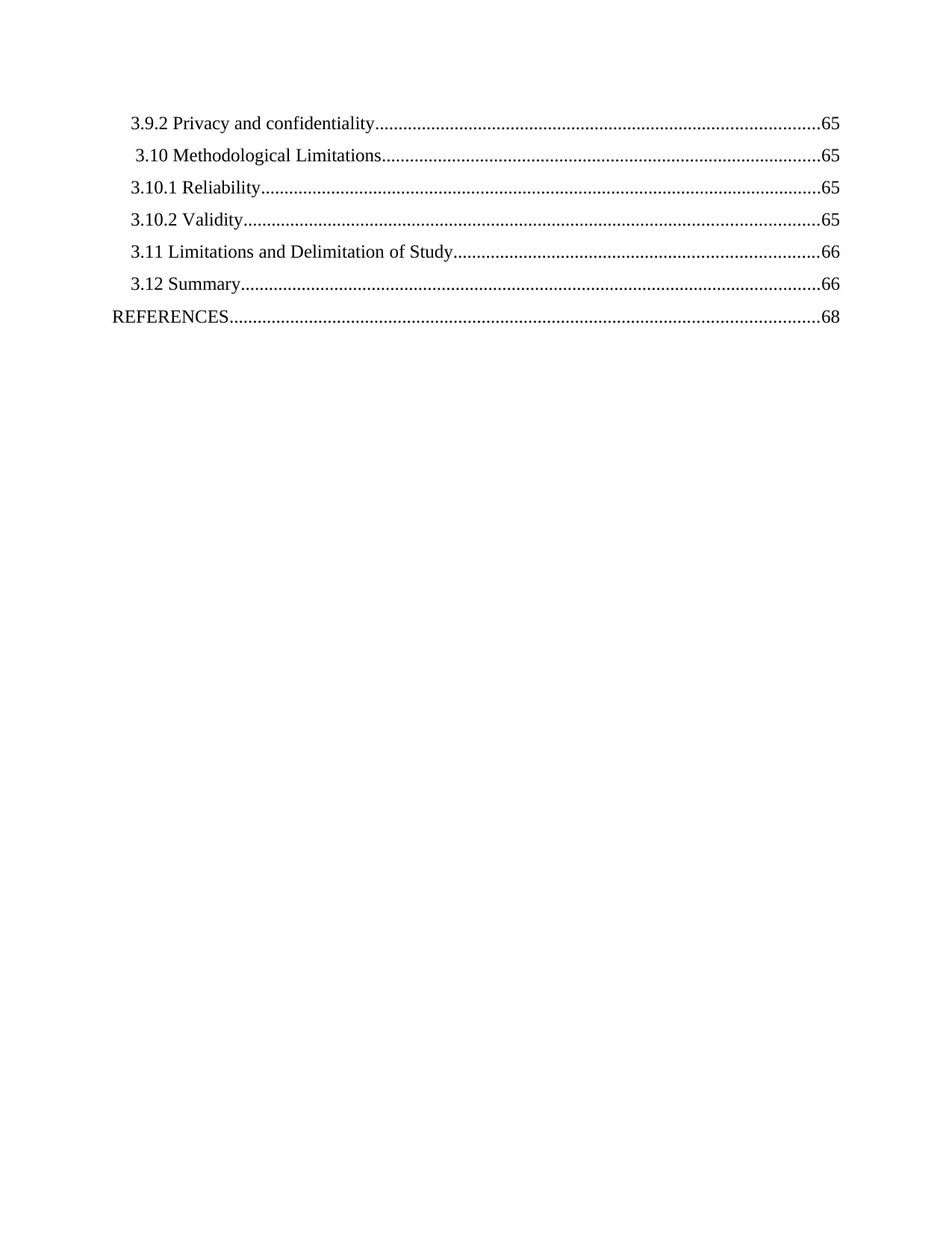
3.9.2 Privacy and confidentiality...............................................................................................65
3.10 Methodological Limitations..............................................................................................65
3.10.1 Reliability........................................................................................................................65
3.10.2 Validity...........................................................................................................................65
3.11 Limitations and Delimitation of Study..............................................................................66
3.12 Summary............................................................................................................................66
REFERENCES..............................................................................................................................68
3.10 Methodological Limitations..............................................................................................65
3.10.1 Reliability........................................................................................................................65
3.10.2 Validity...........................................................................................................................65
3.11 Limitations and Delimitation of Study..............................................................................66
3.12 Summary............................................................................................................................66
REFERENCES..............................................................................................................................68
Paraphrase This Document
Need a fresh take? Get an instant paraphrase of this document with our AI Paraphraser
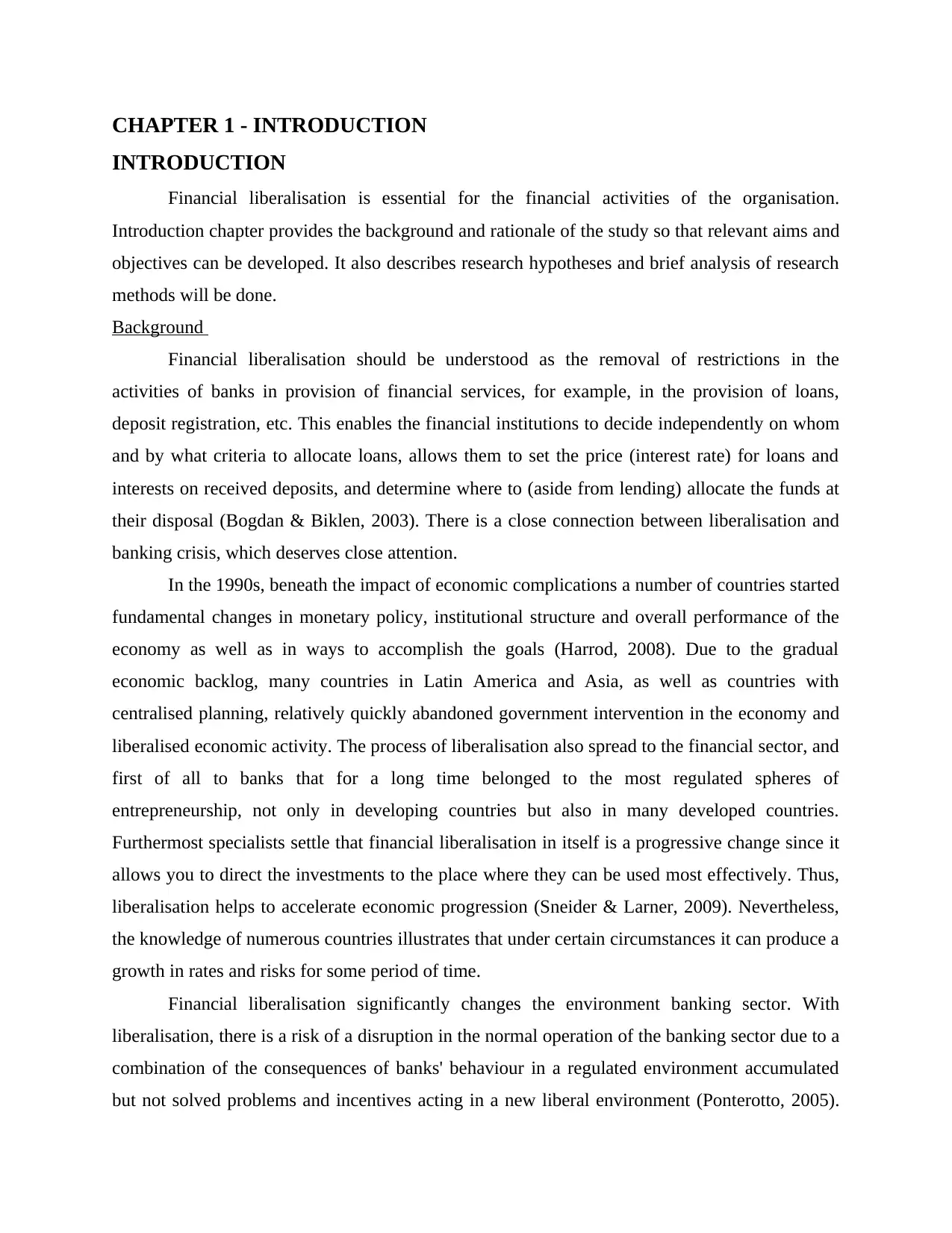
CHAPTER 1 - INTRODUCTION
INTRODUCTION
Financial liberalisation is essential for the financial activities of the organisation.
Introduction chapter provides the background and rationale of the study so that relevant aims and
objectives can be developed. It also describes research hypotheses and brief analysis of research
methods will be done.
Background
Financial liberalisation should be understood as the removal of restrictions in the
activities of banks in provision of financial services, for example, in the provision of loans,
deposit registration, etc. This enables the financial institutions to decide independently on whom
and by what criteria to allocate loans, allows them to set the price (interest rate) for loans and
interests on received deposits, and determine where to (aside from lending) allocate the funds at
their disposal (Bogdan & Biklen, 2003). There is a close connection between liberalisation and
banking crisis, which deserves close attention.
In the 1990s, beneath the impact of economic complications a number of countries started
fundamental changes in monetary policy, institutional structure and overall performance of the
economy as well as in ways to accomplish the goals (Harrod, 2008). Due to the gradual
economic backlog, many countries in Latin America and Asia, as well as countries with
centralised planning, relatively quickly abandoned government intervention in the economy and
liberalised economic activity. The process of liberalisation also spread to the financial sector, and
first of all to banks that for a long time belonged to the most regulated spheres of
entrepreneurship, not only in developing countries but also in many developed countries.
Furthermost specialists settle that financial liberalisation in itself is a progressive change since it
allows you to direct the investments to the place where they can be used most effectively. Thus,
liberalisation helps to accelerate economic progression (Sneider & Larner, 2009). Nevertheless,
the knowledge of numerous countries illustrates that under certain circumstances it can produce a
growth in rates and risks for some period of time.
Financial liberalisation significantly changes the environment banking sector. With
liberalisation, there is a risk of a disruption in the normal operation of the banking sector due to a
combination of the consequences of banks' behaviour in a regulated environment accumulated
but not solved problems and incentives acting in a new liberal environment (Ponterotto, 2005).
INTRODUCTION
Financial liberalisation is essential for the financial activities of the organisation.
Introduction chapter provides the background and rationale of the study so that relevant aims and
objectives can be developed. It also describes research hypotheses and brief analysis of research
methods will be done.
Background
Financial liberalisation should be understood as the removal of restrictions in the
activities of banks in provision of financial services, for example, in the provision of loans,
deposit registration, etc. This enables the financial institutions to decide independently on whom
and by what criteria to allocate loans, allows them to set the price (interest rate) for loans and
interests on received deposits, and determine where to (aside from lending) allocate the funds at
their disposal (Bogdan & Biklen, 2003). There is a close connection between liberalisation and
banking crisis, which deserves close attention.
In the 1990s, beneath the impact of economic complications a number of countries started
fundamental changes in monetary policy, institutional structure and overall performance of the
economy as well as in ways to accomplish the goals (Harrod, 2008). Due to the gradual
economic backlog, many countries in Latin America and Asia, as well as countries with
centralised planning, relatively quickly abandoned government intervention in the economy and
liberalised economic activity. The process of liberalisation also spread to the financial sector, and
first of all to banks that for a long time belonged to the most regulated spheres of
entrepreneurship, not only in developing countries but also in many developed countries.
Furthermost specialists settle that financial liberalisation in itself is a progressive change since it
allows you to direct the investments to the place where they can be used most effectively. Thus,
liberalisation helps to accelerate economic progression (Sneider & Larner, 2009). Nevertheless,
the knowledge of numerous countries illustrates that under certain circumstances it can produce a
growth in rates and risks for some period of time.
Financial liberalisation significantly changes the environment banking sector. With
liberalisation, there is a risk of a disruption in the normal operation of the banking sector due to a
combination of the consequences of banks' behaviour in a regulated environment accumulated
but not solved problems and incentives acting in a new liberal environment (Ponterotto, 2005).
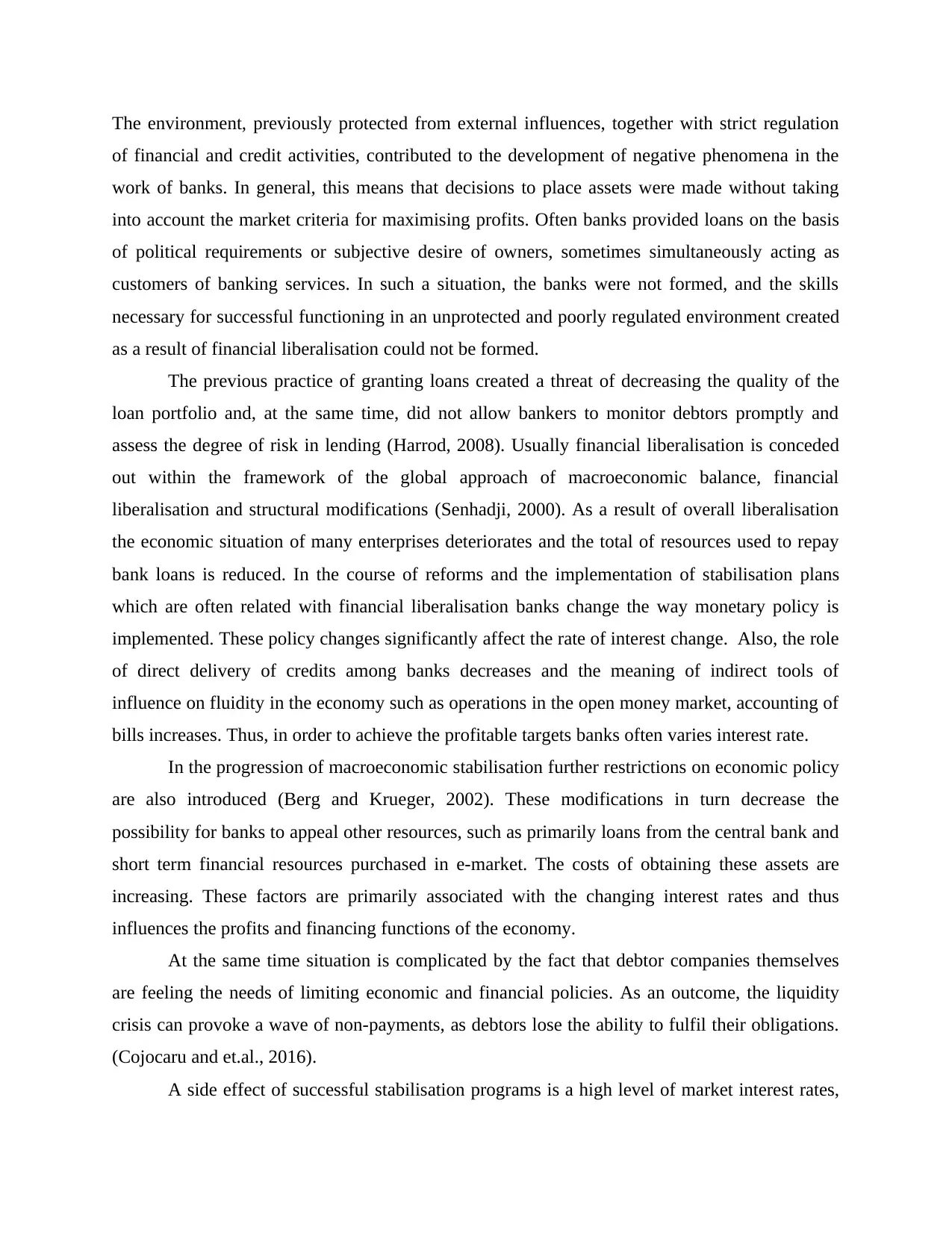
The environment, previously protected from external influences, together with strict regulation
of financial and credit activities, contributed to the development of negative phenomena in the
work of banks. In general, this means that decisions to place assets were made without taking
into account the market criteria for maximising profits. Often banks provided loans on the basis
of political requirements or subjective desire of owners, sometimes simultaneously acting as
customers of banking services. In such a situation, the banks were not formed, and the skills
necessary for successful functioning in an unprotected and poorly regulated environment created
as a result of financial liberalisation could not be formed.
The previous practice of granting loans created a threat of decreasing the quality of the
loan portfolio and, at the same time, did not allow bankers to monitor debtors promptly and
assess the degree of risk in lending (Harrod, 2008). Usually financial liberalisation is conceded
out within the framework of the global approach of macroeconomic balance, financial
liberalisation and structural modifications (Senhadji, 2000). As a result of overall liberalisation
the economic situation of many enterprises deteriorates and the total of resources used to repay
bank loans is reduced. In the course of reforms and the implementation of stabilisation plans
which are often related with financial liberalisation banks change the way monetary policy is
implemented. These policy changes significantly affect the rate of interest change. Also, the role
of direct delivery of credits among banks decreases and the meaning of indirect tools of
influence on fluidity in the economy such as operations in the open money market, accounting of
bills increases. Thus, in order to achieve the profitable targets banks often varies interest rate.
In the progression of macroeconomic stabilisation further restrictions on economic policy
are also introduced (Berg and Krueger, 2002). These modifications in turn decrease the
possibility for banks to appeal other resources, such as primarily loans from the central bank and
short term financial resources purchased in e-market. The costs of obtaining these assets are
increasing. These factors are primarily associated with the changing interest rates and thus
influences the profits and financing functions of the economy.
At the same time situation is complicated by the fact that debtor companies themselves
are feeling the needs of limiting economic and financial policies. As an outcome, the liquidity
crisis can provoke a wave of non-payments, as debtors lose the ability to fulfil their obligations.
(Cojocaru and et.al., 2016).
A side effect of successful stabilisation programs is a high level of market interest rates,
of financial and credit activities, contributed to the development of negative phenomena in the
work of banks. In general, this means that decisions to place assets were made without taking
into account the market criteria for maximising profits. Often banks provided loans on the basis
of political requirements or subjective desire of owners, sometimes simultaneously acting as
customers of banking services. In such a situation, the banks were not formed, and the skills
necessary for successful functioning in an unprotected and poorly regulated environment created
as a result of financial liberalisation could not be formed.
The previous practice of granting loans created a threat of decreasing the quality of the
loan portfolio and, at the same time, did not allow bankers to monitor debtors promptly and
assess the degree of risk in lending (Harrod, 2008). Usually financial liberalisation is conceded
out within the framework of the global approach of macroeconomic balance, financial
liberalisation and structural modifications (Senhadji, 2000). As a result of overall liberalisation
the economic situation of many enterprises deteriorates and the total of resources used to repay
bank loans is reduced. In the course of reforms and the implementation of stabilisation plans
which are often related with financial liberalisation banks change the way monetary policy is
implemented. These policy changes significantly affect the rate of interest change. Also, the role
of direct delivery of credits among banks decreases and the meaning of indirect tools of
influence on fluidity in the economy such as operations in the open money market, accounting of
bills increases. Thus, in order to achieve the profitable targets banks often varies interest rate.
In the progression of macroeconomic stabilisation further restrictions on economic policy
are also introduced (Berg and Krueger, 2002). These modifications in turn decrease the
possibility for banks to appeal other resources, such as primarily loans from the central bank and
short term financial resources purchased in e-market. The costs of obtaining these assets are
increasing. These factors are primarily associated with the changing interest rates and thus
influences the profits and financing functions of the economy.
At the same time situation is complicated by the fact that debtor companies themselves
are feeling the needs of limiting economic and financial policies. As an outcome, the liquidity
crisis can provoke a wave of non-payments, as debtors lose the ability to fulfil their obligations.
(Cojocaru and et.al., 2016).
A side effect of successful stabilisation programs is a high level of market interest rates,
⊘ This is a preview!⊘
Do you want full access?
Subscribe today to unlock all pages.

Trusted by 1+ million students worldwide
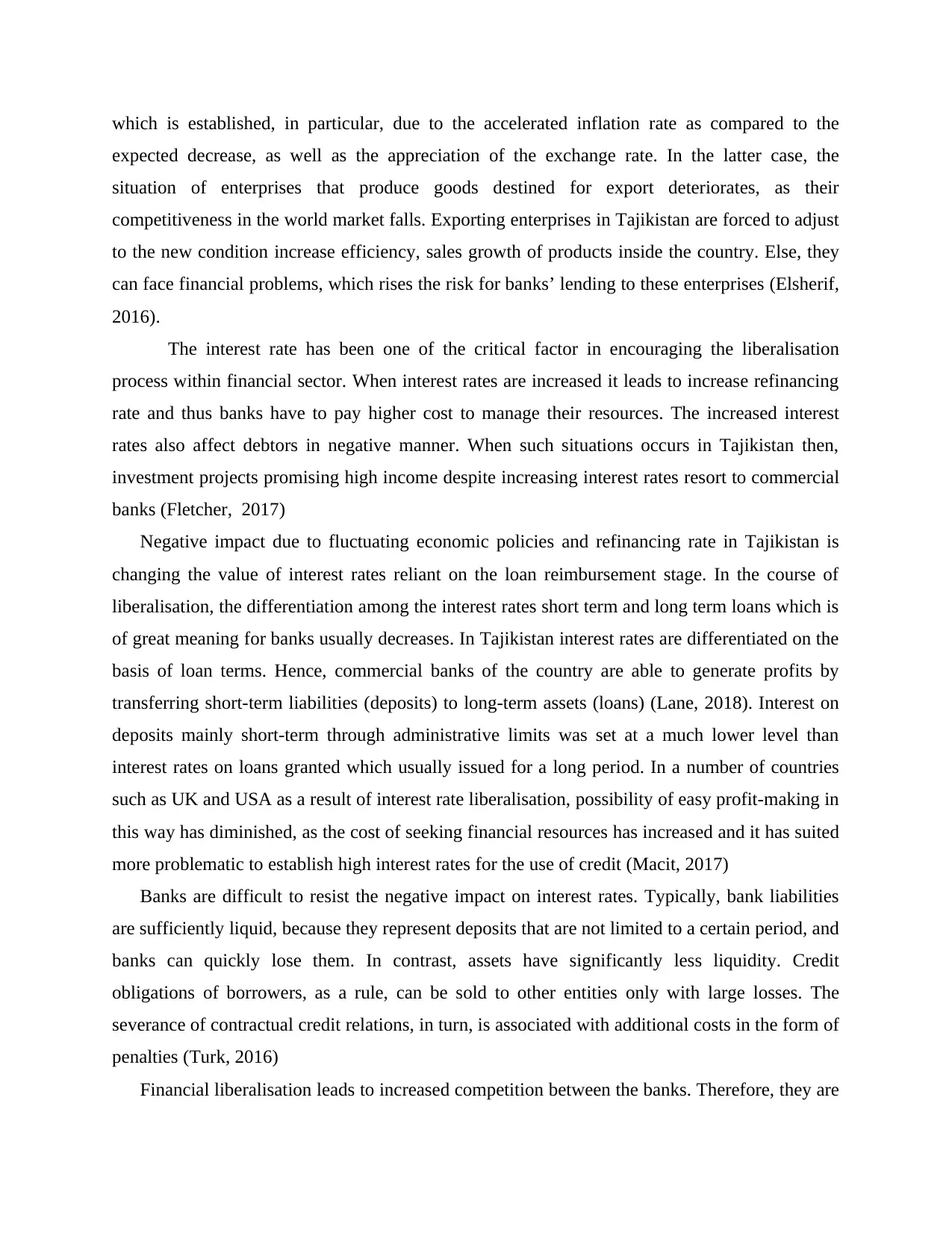
which is established, in particular, due to the accelerated inflation rate as compared to the
expected decrease, as well as the appreciation of the exchange rate. In the latter case, the
situation of enterprises that produce goods destined for export deteriorates, as their
competitiveness in the world market falls. Exporting enterprises in Tajikistan are forced to adjust
to the new condition increase efficiency, sales growth of products inside the country. Else, they
can face financial problems, which rises the risk for banks’ lending to these enterprises (Elsherif,
2016).
The interest rate has been one of the critical factor in encouraging the liberalisation
process within financial sector. When interest rates are increased it leads to increase refinancing
rate and thus banks have to pay higher cost to manage their resources. The increased interest
rates also affect debtors in negative manner. When such situations occurs in Tajikistan then,
investment projects promising high income despite increasing interest rates resort to commercial
banks (Fletcher, 2017)
Negative impact due to fluctuating economic policies and refinancing rate in Tajikistan is
changing the value of interest rates reliant on the loan reimbursement stage. In the course of
liberalisation, the differentiation among the interest rates short term and long term loans which is
of great meaning for banks usually decreases. In Tajikistan interest rates are differentiated on the
basis of loan terms. Hence, commercial banks of the country are able to generate profits by
transferring short-term liabilities (deposits) to long-term assets (loans) (Lane, 2018). Interest on
deposits mainly short-term through administrative limits was set at a much lower level than
interest rates on loans granted which usually issued for a long period. In a number of countries
such as UK and USA as a result of interest rate liberalisation, possibility of easy profit-making in
this way has diminished, as the cost of seeking financial resources has increased and it has suited
more problematic to establish high interest rates for the use of credit (Macit, 2017)
Banks are difficult to resist the negative impact on interest rates. Typically, bank liabilities
are sufficiently liquid, because they represent deposits that are not limited to a certain period, and
banks can quickly lose them. In contrast, assets have significantly less liquidity. Credit
obligations of borrowers, as a rule, can be sold to other entities only with large losses. The
severance of contractual credit relations, in turn, is associated with additional costs in the form of
penalties (Turk, 2016)
Financial liberalisation leads to increased competition between the banks. Therefore, they are
expected decrease, as well as the appreciation of the exchange rate. In the latter case, the
situation of enterprises that produce goods destined for export deteriorates, as their
competitiveness in the world market falls. Exporting enterprises in Tajikistan are forced to adjust
to the new condition increase efficiency, sales growth of products inside the country. Else, they
can face financial problems, which rises the risk for banks’ lending to these enterprises (Elsherif,
2016).
The interest rate has been one of the critical factor in encouraging the liberalisation
process within financial sector. When interest rates are increased it leads to increase refinancing
rate and thus banks have to pay higher cost to manage their resources. The increased interest
rates also affect debtors in negative manner. When such situations occurs in Tajikistan then,
investment projects promising high income despite increasing interest rates resort to commercial
banks (Fletcher, 2017)
Negative impact due to fluctuating economic policies and refinancing rate in Tajikistan is
changing the value of interest rates reliant on the loan reimbursement stage. In the course of
liberalisation, the differentiation among the interest rates short term and long term loans which is
of great meaning for banks usually decreases. In Tajikistan interest rates are differentiated on the
basis of loan terms. Hence, commercial banks of the country are able to generate profits by
transferring short-term liabilities (deposits) to long-term assets (loans) (Lane, 2018). Interest on
deposits mainly short-term through administrative limits was set at a much lower level than
interest rates on loans granted which usually issued for a long period. In a number of countries
such as UK and USA as a result of interest rate liberalisation, possibility of easy profit-making in
this way has diminished, as the cost of seeking financial resources has increased and it has suited
more problematic to establish high interest rates for the use of credit (Macit, 2017)
Banks are difficult to resist the negative impact on interest rates. Typically, bank liabilities
are sufficiently liquid, because they represent deposits that are not limited to a certain period, and
banks can quickly lose them. In contrast, assets have significantly less liquidity. Credit
obligations of borrowers, as a rule, can be sold to other entities only with large losses. The
severance of contractual credit relations, in turn, is associated with additional costs in the form of
penalties (Turk, 2016)
Financial liberalisation leads to increased competition between the banks. Therefore, they are
Paraphrase This Document
Need a fresh take? Get an instant paraphrase of this document with our AI Paraphraser
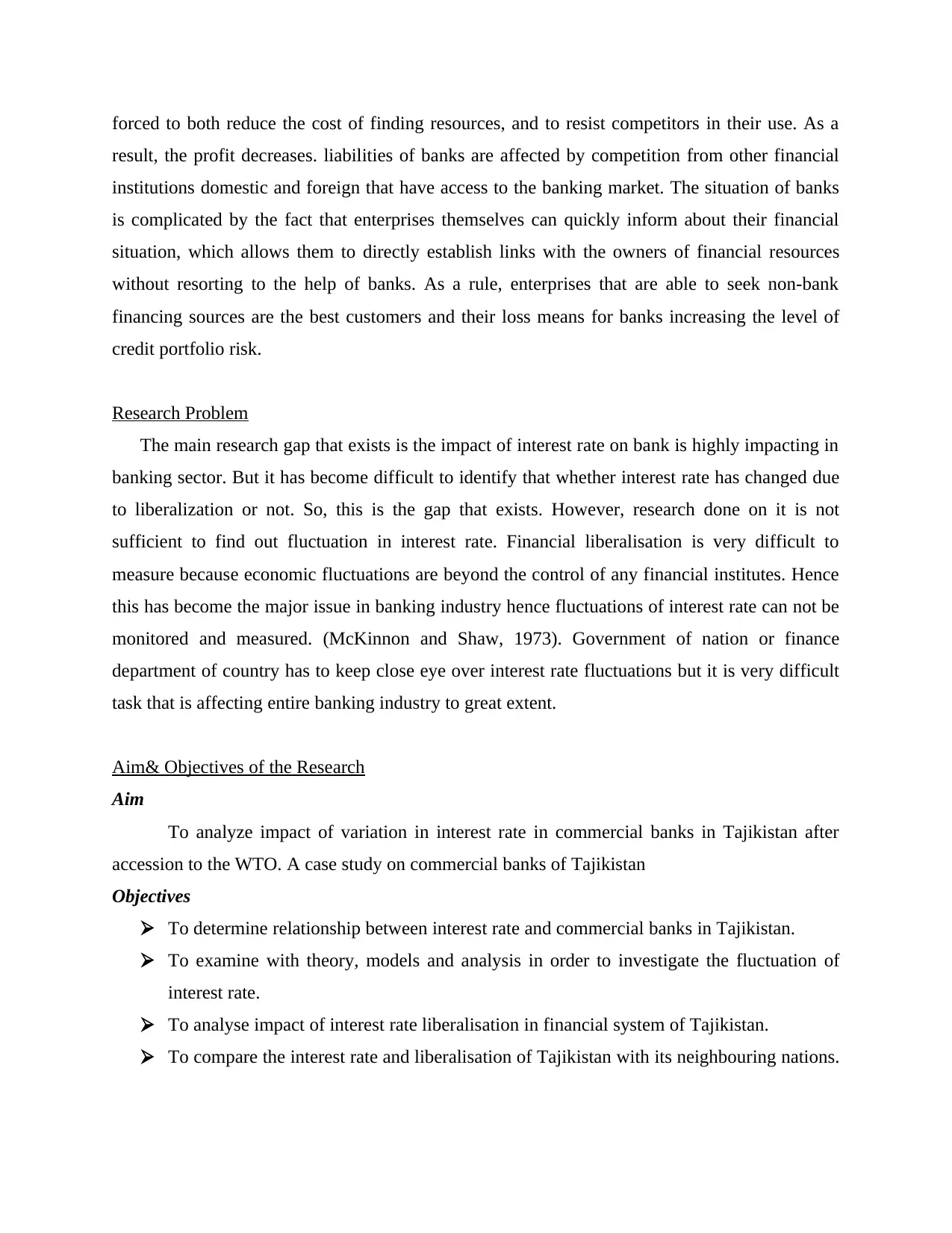
forced to both reduce the cost of finding resources, and to resist competitors in their use. As a
result, the profit decreases. liabilities of banks are affected by competition from other financial
institutions domestic and foreign that have access to the banking market. The situation of banks
is complicated by the fact that enterprises themselves can quickly inform about their financial
situation, which allows them to directly establish links with the owners of financial resources
without resorting to the help of banks. As a rule, enterprises that are able to seek non-bank
financing sources are the best customers and their loss means for banks increasing the level of
credit portfolio risk.
Research Problem
The main research gap that exists is the impact of interest rate on bank is highly impacting in
banking sector. But it has become difficult to identify that whether interest rate has changed due
to liberalization or not. So, this is the gap that exists. However, research done on it is not
sufficient to find out fluctuation in interest rate. Financial liberalisation is very difficult to
measure because economic fluctuations are beyond the control of any financial institutes. Hence
this has become the major issue in banking industry hence fluctuations of interest rate can not be
monitored and measured. (McKinnon and Shaw, 1973). Government of nation or finance
department of country has to keep close eye over interest rate fluctuations but it is very difficult
task that is affecting entire banking industry to great extent.
Aim& Objectives of the Research
Aim
To analyze impact of variation in interest rate in commercial banks in Tajikistan after
accession to the WTO. A case study on commercial banks of Tajikistan
Objectives
To determine relationship between interest rate and commercial banks in Tajikistan.
To examine with theory, models and analysis in order to investigate the fluctuation of
interest rate.
To analyse impact of interest rate liberalisation in financial system of Tajikistan.
To compare the interest rate and liberalisation of Tajikistan with its neighbouring nations.
result, the profit decreases. liabilities of banks are affected by competition from other financial
institutions domestic and foreign that have access to the banking market. The situation of banks
is complicated by the fact that enterprises themselves can quickly inform about their financial
situation, which allows them to directly establish links with the owners of financial resources
without resorting to the help of banks. As a rule, enterprises that are able to seek non-bank
financing sources are the best customers and their loss means for banks increasing the level of
credit portfolio risk.
Research Problem
The main research gap that exists is the impact of interest rate on bank is highly impacting in
banking sector. But it has become difficult to identify that whether interest rate has changed due
to liberalization or not. So, this is the gap that exists. However, research done on it is not
sufficient to find out fluctuation in interest rate. Financial liberalisation is very difficult to
measure because economic fluctuations are beyond the control of any financial institutes. Hence
this has become the major issue in banking industry hence fluctuations of interest rate can not be
monitored and measured. (McKinnon and Shaw, 1973). Government of nation or finance
department of country has to keep close eye over interest rate fluctuations but it is very difficult
task that is affecting entire banking industry to great extent.
Aim& Objectives of the Research
Aim
To analyze impact of variation in interest rate in commercial banks in Tajikistan after
accession to the WTO. A case study on commercial banks of Tajikistan
Objectives
To determine relationship between interest rate and commercial banks in Tajikistan.
To examine with theory, models and analysis in order to investigate the fluctuation of
interest rate.
To analyse impact of interest rate liberalisation in financial system of Tajikistan.
To compare the interest rate and liberalisation of Tajikistan with its neighbouring nations.
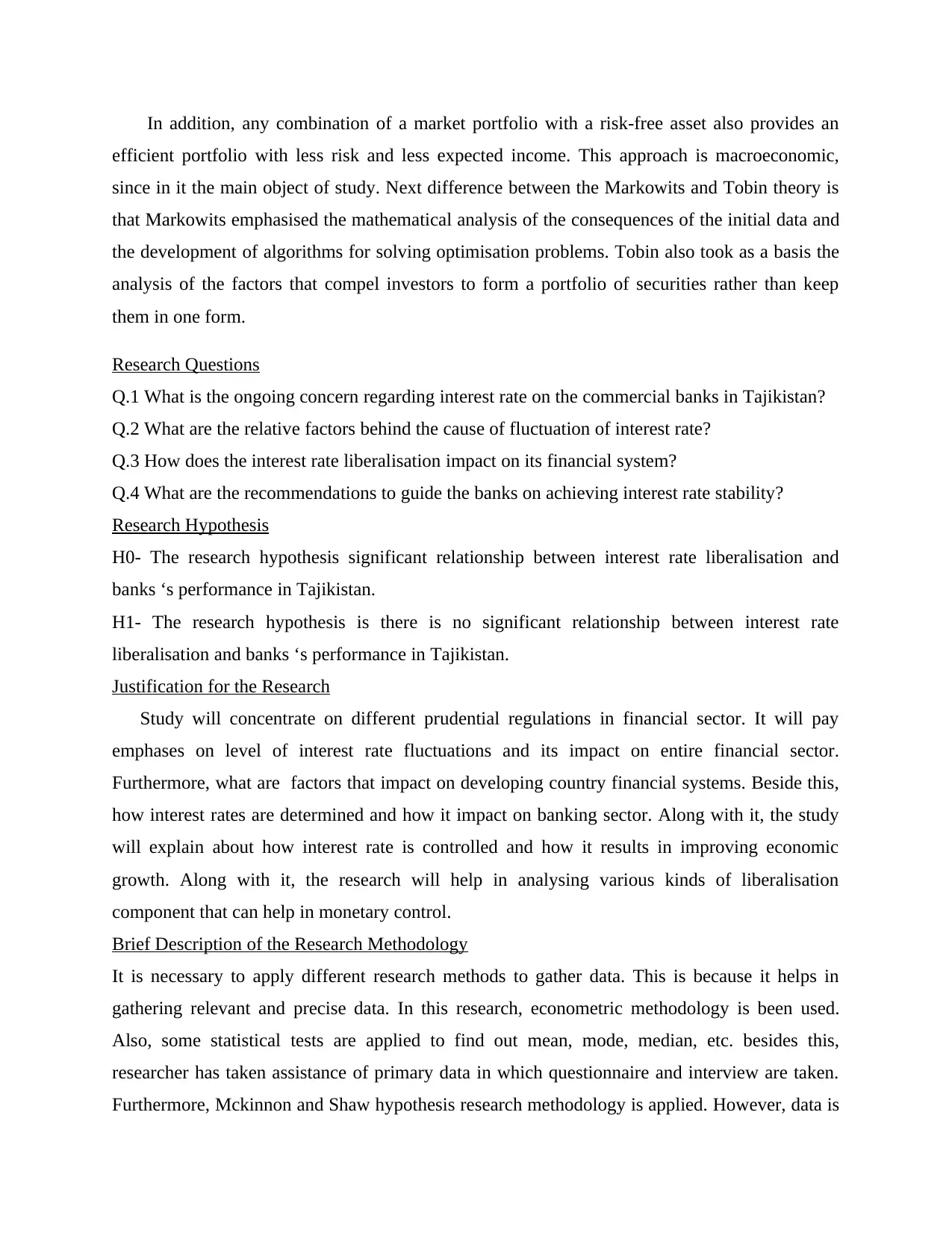
In addition, any combination of a market portfolio with a risk-free asset also provides an
efficient portfolio with less risk and less expected income. This approach is macroeconomic,
since in it the main object of study. Next difference between the Markowits and Tobin theory is
that Markowits emphasised the mathematical analysis of the consequences of the initial data and
the development of algorithms for solving optimisation problems. Tobin also took as a basis the
analysis of the factors that compel investors to form a portfolio of securities rather than keep
them in one form.
Research Questions
Q.1 What is the ongoing concern regarding interest rate on the commercial banks in Tajikistan?
Q.2 What are the relative factors behind the cause of fluctuation of interest rate?
Q.3 How does the interest rate liberalisation impact on its financial system?
Q.4 What are the recommendations to guide the banks on achieving interest rate stability?
Research Hypothesis
H0- The research hypothesis significant relationship between interest rate liberalisation and
banks ‘s performance in Tajikistan.
H1- The research hypothesis is there is no significant relationship between interest rate
liberalisation and banks ‘s performance in Tajikistan.
Justification for the Research
Study will concentrate on different prudential regulations in financial sector. It will pay
emphases on level of interest rate fluctuations and its impact on entire financial sector.
Furthermore, what are factors that impact on developing country financial systems. Beside this,
how interest rates are determined and how it impact on banking sector. Along with it, the study
will explain about how interest rate is controlled and how it results in improving economic
growth. Along with it, the research will help in analysing various kinds of liberalisation
component that can help in monetary control.
Brief Description of the Research Methodology
It is necessary to apply different research methods to gather data. This is because it helps in
gathering relevant and precise data. In this research, econometric methodology is been used.
Also, some statistical tests are applied to find out mean, mode, median, etc. besides this,
researcher has taken assistance of primary data in which questionnaire and interview are taken.
Furthermore, Mckinnon and Shaw hypothesis research methodology is applied. However, data is
efficient portfolio with less risk and less expected income. This approach is macroeconomic,
since in it the main object of study. Next difference between the Markowits and Tobin theory is
that Markowits emphasised the mathematical analysis of the consequences of the initial data and
the development of algorithms for solving optimisation problems. Tobin also took as a basis the
analysis of the factors that compel investors to form a portfolio of securities rather than keep
them in one form.
Research Questions
Q.1 What is the ongoing concern regarding interest rate on the commercial banks in Tajikistan?
Q.2 What are the relative factors behind the cause of fluctuation of interest rate?
Q.3 How does the interest rate liberalisation impact on its financial system?
Q.4 What are the recommendations to guide the banks on achieving interest rate stability?
Research Hypothesis
H0- The research hypothesis significant relationship between interest rate liberalisation and
banks ‘s performance in Tajikistan.
H1- The research hypothesis is there is no significant relationship between interest rate
liberalisation and banks ‘s performance in Tajikistan.
Justification for the Research
Study will concentrate on different prudential regulations in financial sector. It will pay
emphases on level of interest rate fluctuations and its impact on entire financial sector.
Furthermore, what are factors that impact on developing country financial systems. Beside this,
how interest rates are determined and how it impact on banking sector. Along with it, the study
will explain about how interest rate is controlled and how it results in improving economic
growth. Along with it, the research will help in analysing various kinds of liberalisation
component that can help in monetary control.
Brief Description of the Research Methodology
It is necessary to apply different research methods to gather data. This is because it helps in
gathering relevant and precise data. In this research, econometric methodology is been used.
Also, some statistical tests are applied to find out mean, mode, median, etc. besides this,
researcher has taken assistance of primary data in which questionnaire and interview are taken.
Furthermore, Mckinnon and Shaw hypothesis research methodology is applied. However, data is
⊘ This is a preview!⊘
Do you want full access?
Subscribe today to unlock all pages.

Trusted by 1+ million students worldwide
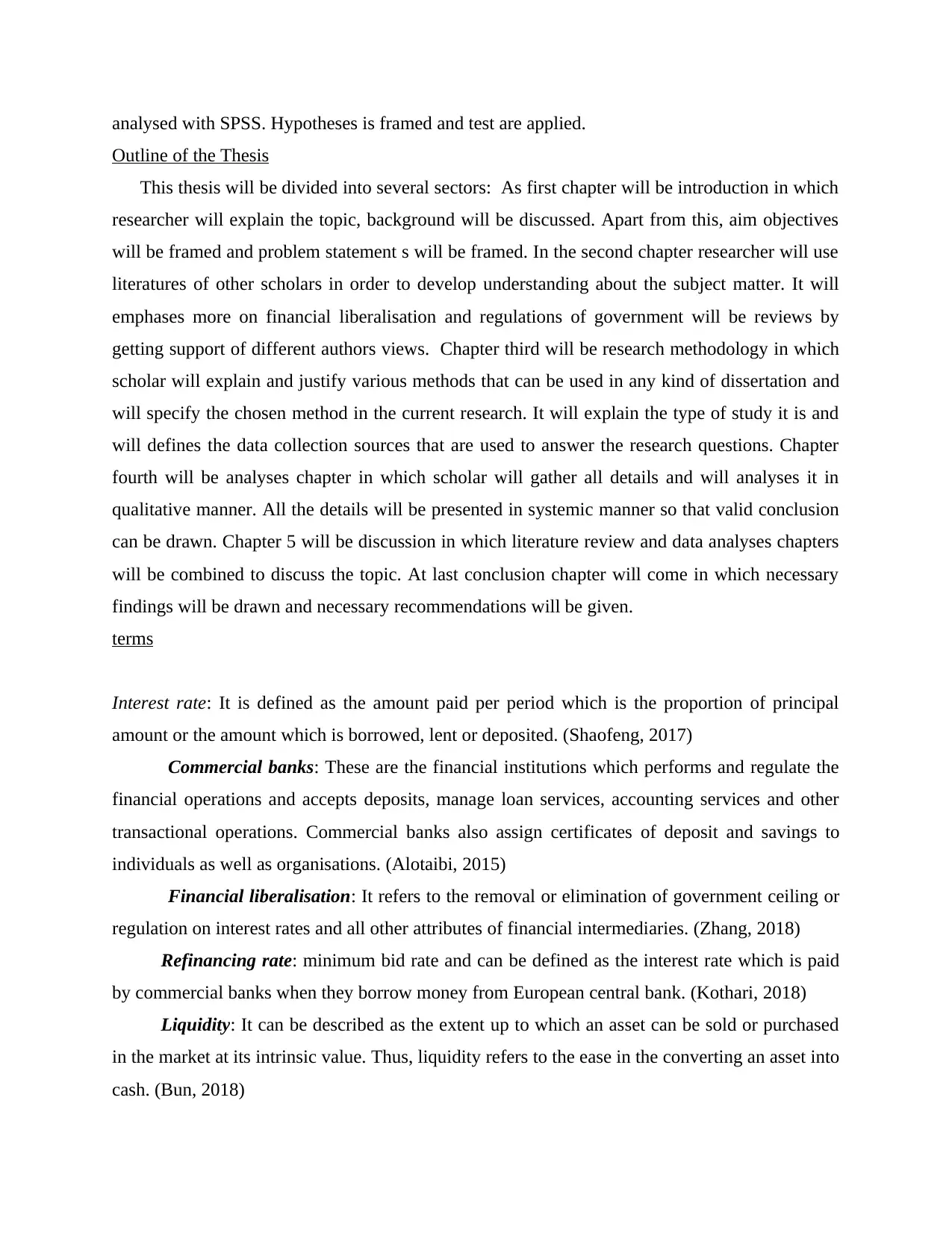
analysed with SPSS. Hypotheses is framed and test are applied.
Outline of the Thesis
This thesis will be divided into several sectors: As first chapter will be introduction in which
researcher will explain the topic, background will be discussed. Apart from this, aim objectives
will be framed and problem statement s will be framed. In the second chapter researcher will use
literatures of other scholars in order to develop understanding about the subject matter. It will
emphases more on financial liberalisation and regulations of government will be reviews by
getting support of different authors views. Chapter third will be research methodology in which
scholar will explain and justify various methods that can be used in any kind of dissertation and
will specify the chosen method in the current research. It will explain the type of study it is and
will defines the data collection sources that are used to answer the research questions. Chapter
fourth will be analyses chapter in which scholar will gather all details and will analyses it in
qualitative manner. All the details will be presented in systemic manner so that valid conclusion
can be drawn. Chapter 5 will be discussion in which literature review and data analyses chapters
will be combined to discuss the topic. At last conclusion chapter will come in which necessary
findings will be drawn and necessary recommendations will be given.
terms
Interest rate: It is defined as the amount paid per period which is the proportion of principal
amount or the amount which is borrowed, lent or deposited. (Shaofeng, 2017)
Commercial banks: These are the financial institutions which performs and regulate the
financial operations and accepts deposits, manage loan services, accounting services and other
transactional operations. Commercial banks also assign certificates of deposit and savings to
individuals as well as organisations. (Alotaibi, 2015)
Financial liberalisation: It refers to the removal or elimination of government ceiling or
regulation on interest rates and all other attributes of financial intermediaries. (Zhang, 2018)
Refinancing rate: minimum bid rate and can be defined as the interest rate which is paid
by commercial banks when they borrow money from European central bank. (Kothari, 2018)
Liquidity: It can be described as the extent up to which an asset can be sold or purchased
in the market at its intrinsic value. Thus, liquidity refers to the ease in the converting an asset into
cash. (Bun, 2018)
Outline of the Thesis
This thesis will be divided into several sectors: As first chapter will be introduction in which
researcher will explain the topic, background will be discussed. Apart from this, aim objectives
will be framed and problem statement s will be framed. In the second chapter researcher will use
literatures of other scholars in order to develop understanding about the subject matter. It will
emphases more on financial liberalisation and regulations of government will be reviews by
getting support of different authors views. Chapter third will be research methodology in which
scholar will explain and justify various methods that can be used in any kind of dissertation and
will specify the chosen method in the current research. It will explain the type of study it is and
will defines the data collection sources that are used to answer the research questions. Chapter
fourth will be analyses chapter in which scholar will gather all details and will analyses it in
qualitative manner. All the details will be presented in systemic manner so that valid conclusion
can be drawn. Chapter 5 will be discussion in which literature review and data analyses chapters
will be combined to discuss the topic. At last conclusion chapter will come in which necessary
findings will be drawn and necessary recommendations will be given.
terms
Interest rate: It is defined as the amount paid per period which is the proportion of principal
amount or the amount which is borrowed, lent or deposited. (Shaofeng, 2017)
Commercial banks: These are the financial institutions which performs and regulate the
financial operations and accepts deposits, manage loan services, accounting services and other
transactional operations. Commercial banks also assign certificates of deposit and savings to
individuals as well as organisations. (Alotaibi, 2015)
Financial liberalisation: It refers to the removal or elimination of government ceiling or
regulation on interest rates and all other attributes of financial intermediaries. (Zhang, 2018)
Refinancing rate: minimum bid rate and can be defined as the interest rate which is paid
by commercial banks when they borrow money from European central bank. (Kothari, 2018)
Liquidity: It can be described as the extent up to which an asset can be sold or purchased
in the market at its intrinsic value. Thus, liquidity refers to the ease in the converting an asset into
cash. (Bun, 2018)
Paraphrase This Document
Need a fresh take? Get an instant paraphrase of this document with our AI Paraphraser
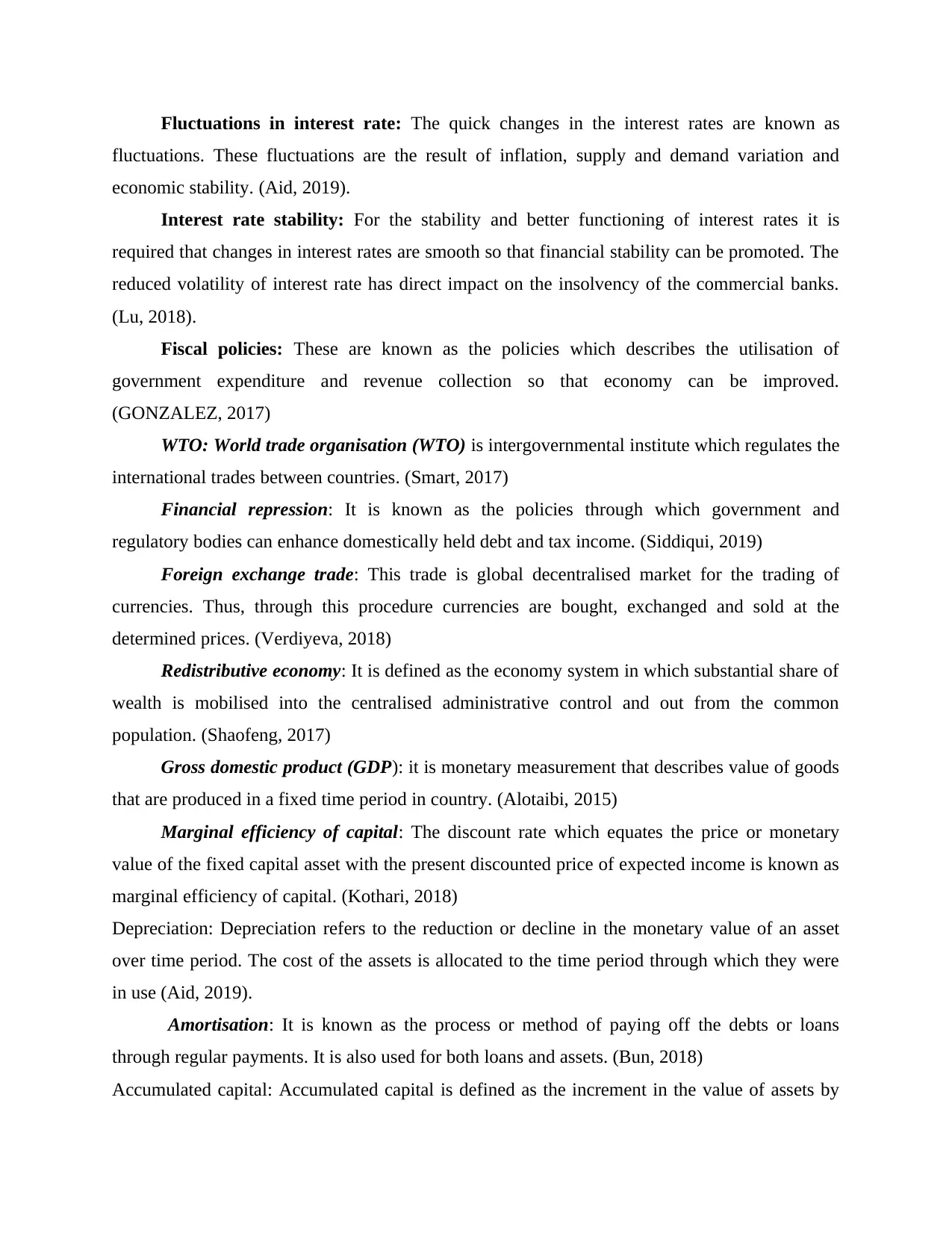
Fluctuations in interest rate: The quick changes in the interest rates are known as
fluctuations. These fluctuations are the result of inflation, supply and demand variation and
economic stability. (Aid, 2019).
Interest rate stability: For the stability and better functioning of interest rates it is
required that changes in interest rates are smooth so that financial stability can be promoted. The
reduced volatility of interest rate has direct impact on the insolvency of the commercial banks.
(Lu, 2018).
Fiscal policies: These are known as the policies which describes the utilisation of
government expenditure and revenue collection so that economy can be improved.
(GONZALEZ, 2017)
WTO: World trade organisation (WTO) is intergovernmental institute which regulates the
international trades between countries. (Smart, 2017)
Financial repression: It is known as the policies through which government and
regulatory bodies can enhance domestically held debt and tax income. (Siddiqui, 2019)
Foreign exchange trade: This trade is global decentralised market for the trading of
currencies. Thus, through this procedure currencies are bought, exchanged and sold at the
determined prices. (Verdiyeva, 2018)
Redistributive economy: It is defined as the economy system in which substantial share of
wealth is mobilised into the centralised administrative control and out from the common
population. (Shaofeng, 2017)
Gross domestic product (GDP): it is monetary measurement that describes value of goods
that are produced in a fixed time period in country. (Alotaibi, 2015)
Marginal efficiency of capital: The discount rate which equates the price or monetary
value of the fixed capital asset with the present discounted price of expected income is known as
marginal efficiency of capital. (Kothari, 2018)
Depreciation: Depreciation refers to the reduction or decline in the monetary value of an asset
over time period. The cost of the assets is allocated to the time period through which they were
in use (Aid, 2019).
Amortisation: It is known as the process or method of paying off the debts or loans
through regular payments. It is also used for both loans and assets. (Bun, 2018)
Accumulated capital: Accumulated capital is defined as the increment in the value of assets by
fluctuations. These fluctuations are the result of inflation, supply and demand variation and
economic stability. (Aid, 2019).
Interest rate stability: For the stability and better functioning of interest rates it is
required that changes in interest rates are smooth so that financial stability can be promoted. The
reduced volatility of interest rate has direct impact on the insolvency of the commercial banks.
(Lu, 2018).
Fiscal policies: These are known as the policies which describes the utilisation of
government expenditure and revenue collection so that economy can be improved.
(GONZALEZ, 2017)
WTO: World trade organisation (WTO) is intergovernmental institute which regulates the
international trades between countries. (Smart, 2017)
Financial repression: It is known as the policies through which government and
regulatory bodies can enhance domestically held debt and tax income. (Siddiqui, 2019)
Foreign exchange trade: This trade is global decentralised market for the trading of
currencies. Thus, through this procedure currencies are bought, exchanged and sold at the
determined prices. (Verdiyeva, 2018)
Redistributive economy: It is defined as the economy system in which substantial share of
wealth is mobilised into the centralised administrative control and out from the common
population. (Shaofeng, 2017)
Gross domestic product (GDP): it is monetary measurement that describes value of goods
that are produced in a fixed time period in country. (Alotaibi, 2015)
Marginal efficiency of capital: The discount rate which equates the price or monetary
value of the fixed capital asset with the present discounted price of expected income is known as
marginal efficiency of capital. (Kothari, 2018)
Depreciation: Depreciation refers to the reduction or decline in the monetary value of an asset
over time period. The cost of the assets is allocated to the time period through which they were
in use (Aid, 2019).
Amortisation: It is known as the process or method of paying off the debts or loans
through regular payments. It is also used for both loans and assets. (Bun, 2018)
Accumulated capital: Accumulated capital is defined as the increment in the value of assets by
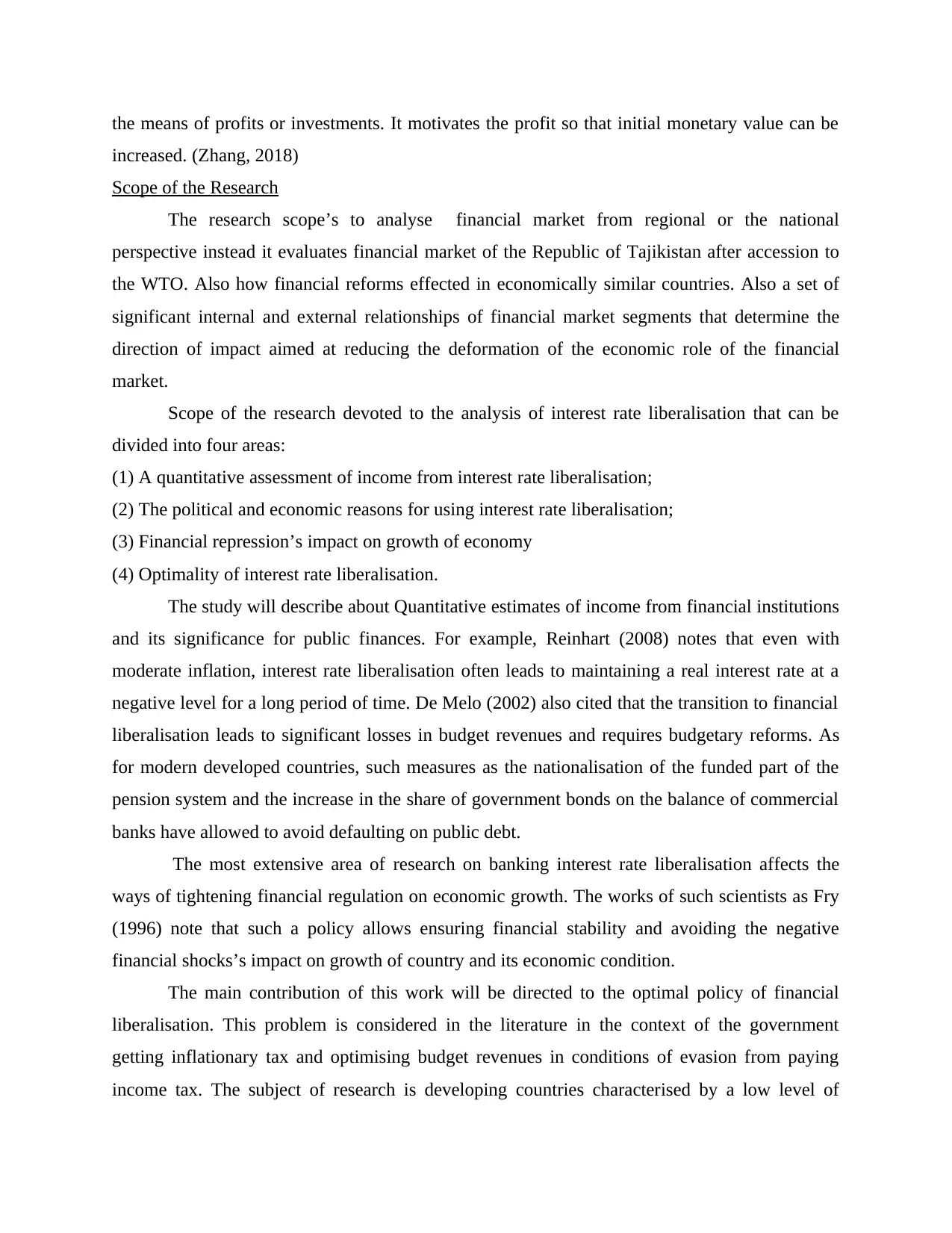
the means of profits or investments. It motivates the profit so that initial monetary value can be
increased. (Zhang, 2018)
Scope of the Research
The research scope’s to analyse financial market from regional or the national
perspective instead it evaluates financial market of the Republic of Tajikistan after accession to
the WTO. Also how financial reforms effected in economically similar countries. Also a set of
significant internal and external relationships of financial market segments that determine the
direction of impact aimed at reducing the deformation of the economic role of the financial
market.
Scope of the research devoted to the analysis of interest rate liberalisation that can be
divided into four areas:
(1) A quantitative assessment of income from interest rate liberalisation;
(2) The political and economic reasons for using interest rate liberalisation;
(3) Financial repression’s impact on growth of economy
(4) Optimality of interest rate liberalisation.
The study will describe about Quantitative estimates of income from financial institutions
and its significance for public finances. For example, Reinhart (2008) notes that even with
moderate inflation, interest rate liberalisation often leads to maintaining a real interest rate at a
negative level for a long period of time. De Melo (2002) also cited that the transition to financial
liberalisation leads to significant losses in budget revenues and requires budgetary reforms. As
for modern developed countries, such measures as the nationalisation of the funded part of the
pension system and the increase in the share of government bonds on the balance of commercial
banks have allowed to avoid defaulting on public debt.
The most extensive area of research on banking interest rate liberalisation affects the
ways of tightening financial regulation on economic growth. The works of such scientists as Fry
(1996) note that such a policy allows ensuring financial stability and avoiding the negative
financial shocks’s impact on growth of country and its economic condition.
The main contribution of this work will be directed to the optimal policy of financial
liberalisation. This problem is considered in the literature in the context of the government
getting inflationary tax and optimising budget revenues in conditions of evasion from paying
income tax. The subject of research is developing countries characterised by a low level of
increased. (Zhang, 2018)
Scope of the Research
The research scope’s to analyse financial market from regional or the national
perspective instead it evaluates financial market of the Republic of Tajikistan after accession to
the WTO. Also how financial reforms effected in economically similar countries. Also a set of
significant internal and external relationships of financial market segments that determine the
direction of impact aimed at reducing the deformation of the economic role of the financial
market.
Scope of the research devoted to the analysis of interest rate liberalisation that can be
divided into four areas:
(1) A quantitative assessment of income from interest rate liberalisation;
(2) The political and economic reasons for using interest rate liberalisation;
(3) Financial repression’s impact on growth of economy
(4) Optimality of interest rate liberalisation.
The study will describe about Quantitative estimates of income from financial institutions
and its significance for public finances. For example, Reinhart (2008) notes that even with
moderate inflation, interest rate liberalisation often leads to maintaining a real interest rate at a
negative level for a long period of time. De Melo (2002) also cited that the transition to financial
liberalisation leads to significant losses in budget revenues and requires budgetary reforms. As
for modern developed countries, such measures as the nationalisation of the funded part of the
pension system and the increase in the share of government bonds on the balance of commercial
banks have allowed to avoid defaulting on public debt.
The most extensive area of research on banking interest rate liberalisation affects the
ways of tightening financial regulation on economic growth. The works of such scientists as Fry
(1996) note that such a policy allows ensuring financial stability and avoiding the negative
financial shocks’s impact on growth of country and its economic condition.
The main contribution of this work will be directed to the optimal policy of financial
liberalisation. This problem is considered in the literature in the context of the government
getting inflationary tax and optimising budget revenues in conditions of evasion from paying
income tax. The subject of research is developing countries characterised by a low level of
⊘ This is a preview!⊘
Do you want full access?
Subscribe today to unlock all pages.

Trusted by 1+ million students worldwide
1 out of 78
Related Documents
Your All-in-One AI-Powered Toolkit for Academic Success.
+13062052269
info@desklib.com
Available 24*7 on WhatsApp / Email
![[object Object]](/_next/static/media/star-bottom.7253800d.svg)
Unlock your academic potential
Copyright © 2020–2025 A2Z Services. All Rights Reserved. Developed and managed by ZUCOL.




